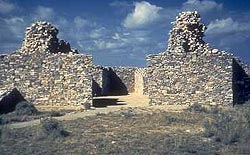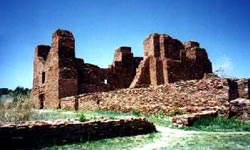
The Salinas Pueblo Missions National Monument, located in Central New Mexico, includes ruins of the Pueblo Indian villages of Quarai, Abó, and Gran Quivira (Las Humanas) as well as the associated mission complexes established by the Spanish in the 17th century. The Pueblo Indians of the Salinas Valley area were descendants of two ancient southwestern cultures, the Anasazi and the Mogollon. From about 1000 to the 1600s, these three villages operated as major regional centers of trade with Indians from the Plains, the Pacific Coast, and the Great Basin. Inhabitants traded agricultural products such as maize, piñon nuts, beans, squash, salt, and cotton goods for dried buffalo meats, hides, flints, and shells. By the 17th century, the Salinas Valley was one of the most populous parts of the Pueblo world. The Pueblo society was divided into different clans, with the female as the center of each clan. They lived in large, stone, apartment-like complexes with hundreds of rooms, surrounding courtyards or plazas. Residents used the rooms for sleeping, for storing food and clothing, and for protection from bad weather. They performed daily activities on the roofs and in the plazas. Kivas, underground structures used for sacred ceremonies and rituals, dotted the plazas. Communal spirituality was very important in Pueblo culture; they felt that participation in the rituals by the entire group maintained the universal harmony that allowed plants and humans to flourish.
Beginning in the 16th century, exploration and colonization by the Spanish greatly influenced the lives of the Pueblo Indians. The Spaniards entered New Mexico in 1598, under the direction of Juan de Oñate, with the purpose of establishing a permanent colony to bring wealth to the Spanish empire. However, the Spaniards quickly learned that New Mexico was not going to be a land of great wealth, and the King of Spain, under the direction of the Pope, agreed that the colony would serve primarily as a missionary effort to Christianize the natives of the New World. The missions established in the Salinas Valley were self-sufficient communities that included the Indian pueblo (village), a church, convento (friars' quarters), work areas, and the pueblo's fields and hunting and gathering areas. Indians received regimented instruction in Christianity as well as European crafts and husbandry in an attempt to bring them into Spanish society. The early years of the missionary effort were peaceful. The friars lived among the Pueblo Indians, preached in the native languages, and did not attempt to destroy their native religion. The Pueblo Indians accepted the Christian God as one of their many gods. A system called encomienda was put into effect in which ranking citizens (encomenderos) were appointed by the governor to provide protection, aid, and education to Indians and military support for the government in return for the privilege of collecting tribute from the Pueblo Indians. However, in the mid-17th century, the tone of the friars' missionary efforts changed and they began an attempt to extinguish the native religion. Resistance from the Pueblo Indians and conflict with the Spanish civil authorities thwarted the friars' conversion process and contributed to the decline of the missions. Documents from the 1600s tell of strife between missionaries and encomenderos, who complained that the friars kept the Indians so busy studying Christianity and building churches that the encomenderos could neither use Indian labor nor collect their tributes. The ruins at Salinas Pueblo Mission National Monument remain as a testament to the friars' efforts and the Spanish colony. Although the Spanish were in the Salinas Valley for less than a hundred years, some changes brought by the Spanish were beneficial. Wheat and wheat bread, fruit trees, and grapes were introduced. Cattle, goats, and sheep became a fixed part of the economy. Craftsmen began working metal, and the Spanish influenced Pueblo black-on-white pottery with European styles. By 1670, famine, raids from other American Indian tribes, and epidemics forced both the Pueblo Indians and the Spanish to abandon their settlements. Today, you can visit the remains of the pueblos and the mission churches to see the result of the earliest contact between the Spanish and the Pueblo Indians.
| ||||||||
|
| ||||||||
 San Buenaventura church,
San Buenaventura church, Nuestra Señora de la Purisma Concepción de
Nuestra Señora de la Purisma Concepción de